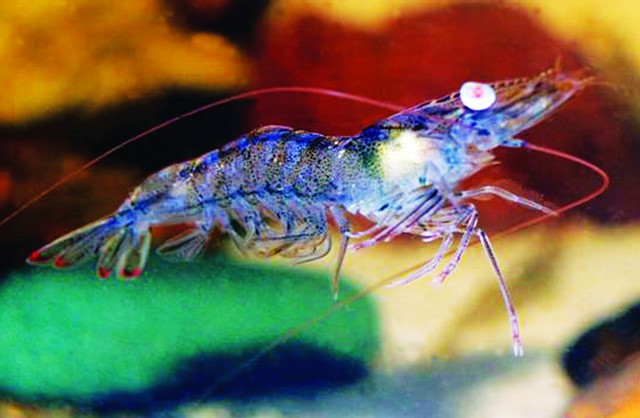Luminous bacterial disease usually occurs in ponds with high salinity (greater than 15 ppt). This disease happens at any developmental stage of shrimp from larvae to adults.
It might be caused by many factors and occur all year round in both black tiger and white leg shrimp, making shrimp stop eating and grow slowly. Also, it significantly affects the crop productivity of farmers.
Therefore, timely disease detection and suitable preventive measures are critical in the shrimp farming process.
Figure 1: Shrimp infected with luminous bacterial disease
1/ Causes
The luminous bacterial disease might be caused by several main factors such as:
– Vibrio (V. harveyi) – It develops fast in conditions of high water temperatures, high organic matter, and low dissolved oxygen. Bacteria enter the shrimp body and secrete an enzyme (Luciferase). This enzyme can emit white or blue light at night, causing the phenomenon of luminous disease.
– Dinoflagellate – They include some species such as Peridinium, Ceratium, Gymnodinium, and others, making the water glows. Although these species are not harmful to shrimp directly, they secrete toxins. These toxins cause liver and intestinal diseases for shrimp, making them reduce eating and grow slowly.
– Luminescence also occurs when the phosphate content in the pond is high due to the high density of shrimp culture, and wastewater contains a lot of phosphorus at the end of the growing season.
– In addition, the disease can be spread from broodstocks of unknown origin, from water sources supplied into ponds and intermediate hosts transmitted the disease.
2/ Symptoms
– The shrimp body is luminous at night when the shrimp swim. Water glows when being impacted by aerations.
Figure 2: Results of samples infected with harmful Vibrio on shrimp
– Observing the shrimp’s muscles and blood through a microscope will detect the luminous bacteria.
– Shrimp reduces eating, grows slowly, and develops unevenly. Moreover, it leads to a slow molting cycle and fouling of shrimp bodies and gills.
– When shrimp is seriously infected, it will stop eating. In addition, its body and gill have gray, and the muscle has muddy. Shrimp is weak, swims lethargic on the edge of ponds, responds slowly, and dies. Depending on the severity of the disease, the mortality rate of shrimp is more or less.
3/ Preventive measures
– Selecting reputable and quality postlarvae hatcheries
Figure 3: Renovating pond
– Renovating the pond according to the production process and conditions
– Limiting the high water temperature in the hot season, keeping the water level in the pond from 1.1-1.3 m
– Stocking density is appropriate according to each species and culture model
– Using probiotics and Hat Sinh Hoc Phu Dien (probiotics) to create watercolor and natural food resources (such as worms, rice snails, and Copepods) before stocking to help shrimp grow fast and have good resistance
Figure 4: Hat Sinh Hoc Phu Dien helps to create natural food
– Checking environmental factors and Vibrio bacteria in pond water periodically 5 days/time
– Periodically using probiotics to decompose an organic matter in the pond bottom and the water, helping the risk of excess phosphorus and stabilizing the water environment
– Managing the amount of feed well and periodically siphoning bottom (if any) to reduce the number of organic matters which causing water pollution in the pond
– Supplying probiotics, digestive enzymes, vitamins, and synthetic minerals to the daily diets of farmed shrimp to reduce stress and boost resistance to shrimp
4/ Treatment
When detecting infected shrimps from the disease symptoms mentioned above:
– Farmers should quickly collect water and shrimp samples (if shrimp are over 20 days old) to the nearest testing place to promptly determine the cause of the disease.
– When shrimp is infected with V.harveyi bacteria: for biosecurity, you can use probiotics with the high content of microorganisms by continuously culturing 2-3 times to inhibit harmful bacteria and supply beneficial microorganisms, combined with digestive enzymes and products to increase the resistance of shrimp.
– When shrimp is infected by Dinoflagellate: you should change the water from 30-50% and use products that reduce toxic algae. After that, using probiotics, synthetic minerals, and dolomite lime to create the watercolor, inhibit and overwhelm harmful algae.
Although luminous bacteria disease is not more dangerous than other serious diseases, it also significantly affects the growth and development of shrimp. Therefore, farmers should apply preventive measures right from the beginning of the crop.
Master Huynh Duy Phong – Binh Minh Aquaculture Development Co., Ltd
DOMESTICATED SHRIMP POSTLARVAE – THE KEY TO SUCCESS
See more:
- Ecuador hosts global shrimp buyers for second shrimp summit
- Shrimp market Update: facing new challenges
- Insights into omega-3s in aquafeeds

 Tiếng Việt
Tiếng Việt 中文 (中国)
中文 (中国)


